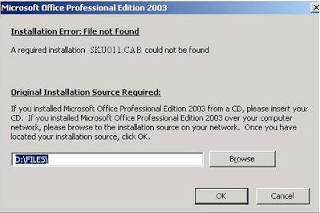 Every so often we must upgrade our Office or Outlook products to the latest and greatest version, or uninstall a product we no longer use because we've switched over to a new solution. Sometimes when we go to remove, repair or upgrade Microsoft Outlook or Office we run into a snag where the system tells us it cannot complete the function without the missing file known as SKU011.CAB, because it cannot be found.
Every so often we must upgrade our Office or Outlook products to the latest and greatest version, or uninstall a product we no longer use because we've switched over to a new solution. Sometimes when we go to remove, repair or upgrade Microsoft Outlook or Office we run into a snag where the system tells us it cannot complete the function without the missing file known as SKU011.CAB, because it cannot be found.The dialogue window which opens can be misleading, telling us we need to place the installation source disc in the machine and browse to where the missing file is located. If you are like some small to medium-sized businesses which have just recently gotten around to focusing on updating your software products, you may find that the original discs have gone missing, or the IT personnel you used when the business was a fresh start have disappeared or are no longer the same folks you use to perform your technology duties, and the software actually was with them.
In the case above, there is actually a simple and easy way to work around this issue by modifying the Windows registry. This corrupt installation issue is actually due to a value in the registry not being "0".
Now, before attempting to modify any registry data, check to see if you have staff comfortable doing this task as it can wreck your Windows profile if changes are made in error or if items are deleted by accident. Windows registry is no joke, it is literally a database of all the different components which Windows uses to function properly. Check to see if you have an assigned IT person, and if not, backup your registry before modifying any registry keys.
FIRST: BACKING UP WINDOWS REGISTRY DATA:
To backup Windows registry is a very simple matter which takes only a minute or two. Any time you need to edit the registry, you go to Start > Run, and in the dialogue box type "regedit" (without the quotation marks), and press Enter.
-
Open the Registry Editor by clicking the Start button
 , typing regedit into the Search box, and then pressing ENTER.
, typing regedit into the Search box, and then pressing ENTER.  If you are prompted for an administrator password or confirmation, type the password or provide confirmation.
If you are prompted for an administrator password or confirmation, type the password or provide confirmation. -
Locate and click the key or subkey that you want to back up.
-
Click the File menu, and then click Export.
-
In the Save in box, select the location where you want to save the backup copy, and then type a name for the backup file in the File name box.
-
Click Save.
-
Although you can back up more than the registry key or subkey that you are modifying, doing so adds to the size of the backup file.
-
Before editing the registry, it's a good idea to create a restore point using System Restore. The restore point contains information about the registry, and you can use the restore point to undo changes to your system. For more information, search Help and Support for "System Restore."
Fixing The Irritating Missing File Issue:
1. Click on your Start menu and select “Run…”
2. Once the dialogue box appears, type in 'regedit' and click “OK”
3. In the left tree structure, navigate to HKEY_LOCAL_MACHINE -> Software->Microsoft -> Office -> 11.0 -> Delivery.
4. There should be one entry under Delivery folder (e.g. {91E30409-6000-11D3-8CFE-0150048383C9} ), select that directory. (Don't select any other directory but this one, as this is specific to the issue shown at the top! If you cannot find it or are unsure, consult an IT professional!)
5. On the right side of the window, right-click on CDCache and select the first menu item ‘Modify’.
6. An ‘Edit String’ dialogue box will appear on your screen. Make sure to note the current value in this box incase you want to revert the changes that you have made. Change the value in the ‘Value Data:’ field to 0 and click ‘OK’. Once this is done, your registry will have been updated.
7. This completes the necessary changes that need to be made in order to fix the error message that appears in figure 1. Now that you are done, close all the windows that you opened and restart your Microsoft Office product.
An excellent resource for screenshots so that you may follow the steps visually can be found here at http://www.sku011cab.com/
Now you should be able to add/remove, change, repair or upgrade the Office product without that nasty error popping up.
Again, make sure you or someone in your office is comfortable backing up and modifying the registry data, it could save you much time and frustration going forward!



